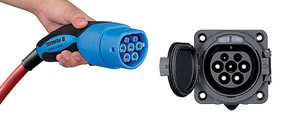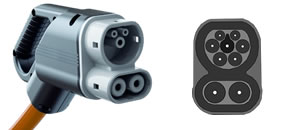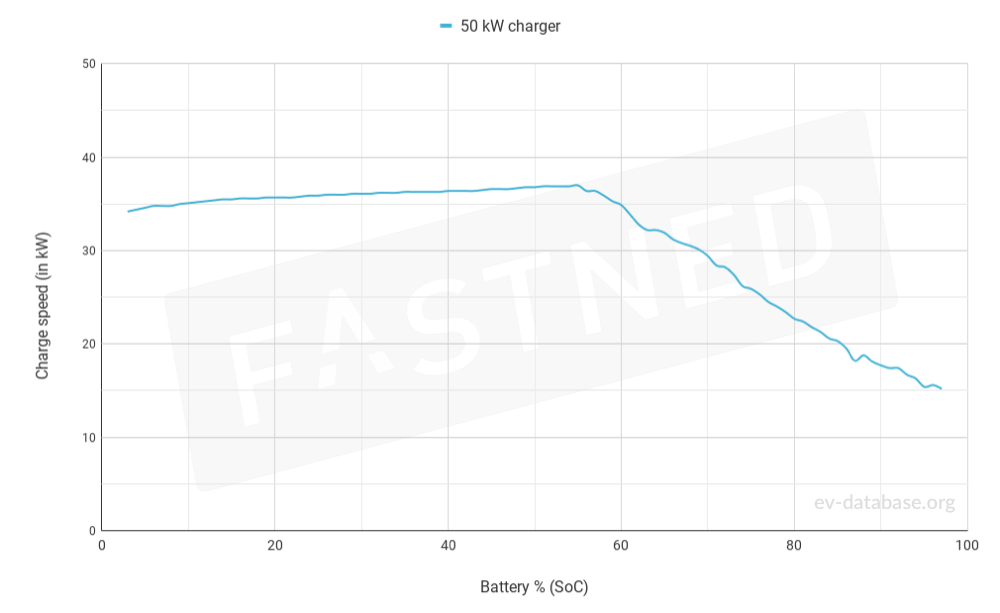
Cart is empty. Please go to your home page for listing it.
30.0 kWh *Useable Battery
450-500 kmReal Range
176 Wh/kmEfficiency
| City - Cold Weather | 170 km |
| Highway - Cold Weather | 120 km |
| Combined - Cold Weather | 145 km |
| City - Mild Weather | 255 km |
| Highway - Mild Weather | 155 km |
| Combined - Mild Weather | 195 km |
| Acceleration 0 - 100 km/h | 9.7 sec |
| Top Speed | 140 km/h |
| Electric Range | 170 km |
| Total Power | 105 kW (143 PS) |
| Total Torque | 265 Nm |
| Drive | Front |
| Nominal Capacity | 35.5 kWh |
| Battery Type | Lithium-ion |
| Number of Cells | No Data |
| Architecture | 400 V |
| Useable Capacity* | 30.0 kWh |
| Cathode Material | No Data |
| Pack Configuration | No Data |
| Nominal Voltage | No Data |
| Charge Port | Type 2 |
| Port Location | Right Side - Rear |
| Charge Power | 6.6 kW AC |
| Charge Time (0->170 km) | 5h30m |
| Charge Speed | 32 km/h |
| Fastcharge Port | CCS |
| FC Port Location | Right Side - Rear |
| Fastcharge Power (max) | 37 kW DC |
| Fastcharge Time (17->136 km) | 39 min |
| Fastcharge Speed | 180 km/h |
| Range | 170 km |
| Vehicle Consumption | 176 Wh/km |
| CO2 Emissions | 0 g/km |
| Vehicle Fuel Equivalent | 2.0 l/100km |
| Range | 237 km |
| Rated Consumption | 173 Wh/km |
| Vehicle Consumption | 127 Wh/km |
| CO2 Emissions | 0 g/km |
| Rated Fuel Equivalent | 1.9 l/100km |
| Vehicle Fuel Equivalent | 1.4 l/100km |
| Range | 200 km |
| Rated Consumption | 190 Wh/km |
| Vehicle Consumption | 150 Wh/km |
| CO2 Emissions | 0 g/km |
| Rated Fuel Equivalent | 2.1 l/100km |
| Vehicle Fuel Equivalent | 1.7 l/100km |
| City - Cold Weather | 176 Wh/km |
| Highway - Cold Weather | 250 Wh/km |
| Combined - Cold Weather | 207 Wh/km |
| City - Mild Weather | 118 Wh/km |
| Highway - Mild Weather | 194 Wh/km |
| Combined - Mild Weather | 154 Wh/km |
| Safety Rating | |
| Adult Occupant | 91% |
| Child Occupant | 87% |
| Rating Year | 2020 |
| Vulnerable Road Users | 68% |
| Safety Assist | 73% |
| Length | 4395 mm |
| Width | 1795 mm |
| Width with mirrors | 2035 mm |
| Height | 1555 mm |
| Wheelbase | 2655 mm |
| Weight Unladen (EU) | 1720 kg |
| Gross Vehicle Weight (GVWR) | 2119 kg |
| Max. Payload | 474 kg |
| Cargo Volume | 366 L |
| Cargo Volume Max | 1171 L |
| Cargo Volume Frunk | 0 L |
| Roof Load | 75 kg |
| Tow Hitch Possible | No |
| Towing Weight Unbraked | 0 kg |
| Towing Weight Braked | 0 kg |
| Vertical Load Max | 0 kg |
| Seats | 5 people |
| Isofix | Yes, 2 seats |
| Turning Circle | 11.4 m |
| Platform | No Data |
| Car Body | SUV |
| Segment | JC - Medium |
| Roof Rails | No |
| EV Dedicated Platform | No |
Charging is possible by using a regular wall plug or a charging station. Public charging is always done through a charging station. How fast the EV can charge depends on the charging station (EVSE) used and the maximum charging capacity of the EV. The table below shows all possible options for charging the Mazda MX-30. Each option shows how fast the battery can be charged from empty to full.
Charging an EV in Europe differs by country. Some European countries primarily use 1-phase connections to the grid, while other countries are almost exclusively using a 3-phase connection. The table below shows all possible ways the Mazda MX-30 can be charged, but some modes of charging might not be widely available in certain countries.
| Type 2 (Mennekes - IEC 62196) |
|---|
 |
| Charging Point | Max. Power | Power | Time | Rate |
|---|---|---|---|---|
| Wall Plug (2.3 kW) | 230V / 1x10A | 2.3 kW | 15h30m | 11 km/h |
| 1-phase 16A (3.7 kW) | 230V / 1x16A | 3.7 kW | 9h45m | 17 km/h |
| 1-phase 32A (7.4 kW) | 230V / 1x29A | 6.6 kW † | 5h30m | 31 km/h |
| 3-phase 16A (11 kW) | 230V / 1x16A | 3.7 kW † | 9h45m | 17 km/h |
| 3-phase 32A (22 kW) | 230V / 1x29A | 6.6 kW † | 5h30m | 31 km/h |
† = Limited by on-board charger, vehicle cannot charge faster.
Rapid charging enables longer journeys by adding as much range as possible in the shortest amount of time. Charging power will decrease significantly after 80% state-of-charge has been reached. A typical rapid charge therefore rarely exceeds 80% SoC. The rapid charge rate of an EV depends on the charger used and the maximum charging power the EV can handle. The table below shows all details for rapid charging the Mazda MX-30.
Read more about rapid charging of the Mazda MX-30 on the Fastned website.
| Combined Charging System (CCS Combo 2) |
|---|
 |
| Charging Point | Max. Power | Avg. Power | Time | Rate |
|---|---|---|---|---|
| CCS (50 kW DC) | 37 kW † | 34 kW † | 39 min | 180 km/h |
| Charge Curve |
|---|
 |
Data made available by Fastned |
| This vehicle does not support Autocharge |
|---|
† = Limited by charging capabilities of vehicle
Autocharge: allows for a vehicle to initiate charging automatically on supported CCS charge points.
Actual charging rates may differ from data shown due to factors like outside temperature, state of the battery and driving style.
30.0 kWh *Useable Battery
170 kmReal Range
176 Wh/kmEfficiency
| City - Cold Weather | 170 km |
| Highway - Cold Weather | 120 km |
| Combined - Cold Weather | 145 km |
| City - Mild Weather | 255 km |
| Highway - Mild Weather | 155 km |
| Combined - Mild Weather | 195 km |
| Acceleration 0 - 100 km/h | 9.7 sec |
| Top Speed | 140 km/h |
| Electric Range | 170 km |
| Total Power | 105 kW (143 PS) |
| Total Torque | 265 Nm |
| Drive | Front |
| Nominal Capacity | 35.5 kWh |
| Battery Type | Lithium-ion |
| Number of Cells | No Data |
| Architecture | 400 V |
| Useable Capacity* | 30.0 kWh |
| Cathode Material | No Data |
| Pack Configuration | No Data |
| Nominal Voltage | No Data |
| Charge Port | Type 2 |
| Port Location | Right Side - Rear |
| Charge Power | 6.6 kW AC |
| Charge Time (0->170 km) | 5h30m |
| Charge Speed | 32 km/h |
| Fastcharge Port | CCS |
| FC Port Location | Right Side - Rear |
| Fastcharge Power (max) | 37 kW DC |
| Fastcharge Time (17->136 km) | 39 min |
| Fastcharge Speed | 180 km/h |
| Range | 170 km |
| Vehicle Consumption | 176 Wh/km |
| CO2 Emissions | 0 g/km |
| Vehicle Fuel Equivalent | 2.0 l/100km |
| Range | 237 km |
| Rated Consumption | 173 Wh/km |
| Vehicle Consumption | 127 Wh/km |
| CO2 Emissions | 0 g/km |
| Rated Fuel Equivalent | 1.9 l/100km |
| Vehicle Fuel Equivalent | 1.4 l/100km |
| Range | 200 km |
| Rated Consumption | 190 Wh/km |
| Vehicle Consumption | 150 Wh/km |
| CO2 Emissions | 0 g/km |
| Rated Fuel Equivalent | 2.1 l/100km |
| Vehicle Fuel Equivalent | 1.7 l/100km |
| City - Cold Weather | 176 Wh/km |
| Highway - Cold Weather | 250 Wh/km |
| Combined - Cold Weather | 207 Wh/km |
| City - Mild Weather | 118 Wh/km |
| Highway - Mild Weather | 194 Wh/km |
| Combined - Mild Weather | 154 Wh/km |
| Safety Rating | |
| Adult Occupant | 91% |
| Child Occupant | 87% |
| Rating Year | 2020 |
| Vulnerable Road Users | 68% |
| Safety Assist | 73% |
| Length | 4395 mm |
| Width | 1795 mm |
| Width with mirrors | 2035 mm |
| Height | 1555 mm |
| Wheelbase | 2655 mm |
| Weight Unladen (EU) | 1720 kg |
| Gross Vehicle Weight (GVWR) | 2119 kg |
| Max. Payload | 474 kg |
| Cargo Volume | 366 L |
| Cargo Volume Max | 1171 L |
| Cargo Volume Frunk | 0 L |
| Roof Load | 75 kg |
| Tow Hitch Possible | No |
| Towing Weight Unbraked | 0 kg |
| Towing Weight Braked | 0 kg |
| Vertical Load Max | 0 kg |
| Seats | 5 people |
| Isofix | Yes, 2 seats |
| Turning Circle | 11.4 m |
| Platform | No Data |
| Car Body | SUV |
| Segment | JC - Medium |
| Roof Rails | No |
| EV Dedicated Platform | No |
Charging is possible by using a regular wall plug or a charging station. Public charging is always done through a charging station. How fast the EV can charge depends on the charging station (EVSE) used and the maximum charging capacity of the EV. The table below shows all possible options for charging the Mazda MX-30. Each option shows how fast the battery can be charged from empty to full.
Charging an EV in Europe differs by country. Some European countries primarily use 1-phase connections to the grid, while other countries are almost exclusively using a 3-phase connection. The table below shows all possible ways the Mazda MX-30 can be charged, but some modes of charging might not be widely available in certain countries.
| Type 2 (Mennekes - IEC 62196) |
|---|
 |
| Charging Point | Max. Power | Power | Time | Rate |
|---|---|---|---|---|
| Wall Plug (2.3 kW) | 230V / 1x10A | 2.3 kW | 15h30m | 11 km/h |
| 1-phase 16A (3.7 kW) | 230V / 1x16A | 3.7 kW | 9h45m | 17 km/h |
| 1-phase 32A (7.4 kW) | 230V / 1x29A | 6.6 kW † | 5h30m | 31 km/h |
| 3-phase 16A (11 kW) | 230V / 1x16A | 3.7 kW † | 9h45m | 17 km/h |
| 3-phase 32A (22 kW) | 230V / 1x29A | 6.6 kW † | 5h30m | 31 km/h |
† = Limited by on-board charger, vehicle cannot charge faster.
Rapid charging enables longer journeys by adding as much range as possible in the shortest amount of time. Charging power will decrease significantly after 80% state-of-charge has been reached. A typical rapid charge therefore rarely exceeds 80% SoC. The rapid charge rate of an EV depends on the charger used and the maximum charging power the EV can handle. The table below shows all details for rapid charging the Mazda MX-30.
Read more about rapid charging of the Mazda MX-30 on the Fastned website.
| Combined Charging System (CCS Combo 2) |
|---|
 |
| Charging Point | Max. Power | Avg. Power | Time | Rate |
|---|---|---|---|---|
| CCS (50 kW DC) | 37 kW † | 34 kW † | 39 min | 180 km/h |
| Charge Curve |
|---|
 |
Data made available by Fastned |
| This vehicle does not support Autocharge |
|---|
† = Limited by charging capabilities of vehicle
Autocharge: allows for a vehicle to initiate charging automatically on supported CCS charge points.
Actual charging rates may differ from data shown due to factors like outside temperature, state of the battery and driving style.